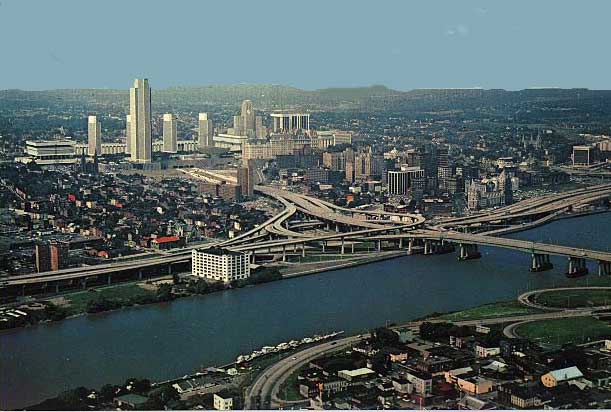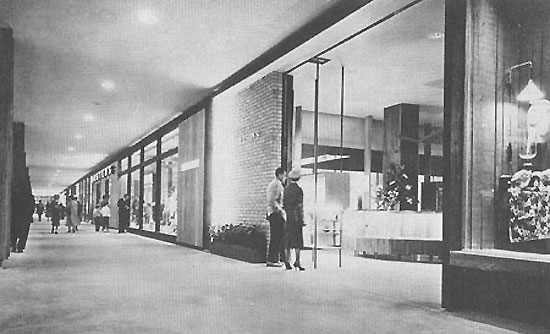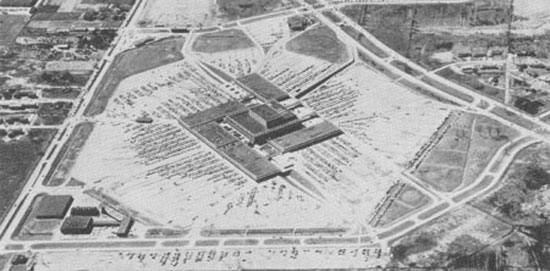

160 the canon of bad design
The
city centers of the prosperous sunbelt generally suffered the most in
the decades of the postwar Catastrophe, as speculators flattened
thousands of buildings for parking or new office blocks. A
special prize for wanton self-destruction, though, may go to
the economically moribund state of New York.
This is Albany, or what's left of it. Governor Nelson Rockefeller gets credit for the Empire State Plaza, at top left. This creepy glorification of the liberal state, looming like some alien base of occupation, required the destruction of an entire historic neighborhood. The massive freeway that devastated downtown and cut the city off from the Hudson is typical postwar New York State highway design. It might come as a surprise to learn that modern America practices urban design at all. But 'design is what everybody does all the time', as Charles Jencks and Nathan Silver put it, and if we can find a pattern, isolate the common practices of a nation at a given time, we have defined a canon of design. There will be a curious split between what is taught in the schools and what actually gets built, but this is a worldwide phenomenon. From the 20's on, academic thought in urban design everywhere decayed into sterile utopian theorizing and pseudo-scientific analysis, while everyone who was actually building, public or private, had arrived at some common approaches on their own. Over time, the Modernist crusade gradually shrivelled and faded, but no one was coming up with creative alternatives, and many of its precepts found their way into the common habits of builders everywhere. Because of its ad-hoc nature, it was something we took for granted, so much so that no one ever gave it a name. We might call it bad design. The individual elements are familiar: the carelessly-planned urban freeway, the strip mall and auto strip, the superblock housing project and garden apartment, the cul-de-sac subdivision. Some of the hidden principles of bad need a little airing out. At this point, we can see many things come together: the megaproject of the new corporate economy (Cleveland's Terminal-Shaker complex, Rockefeller Center) merges with Modernist theory, scientistic social intervention and postwar urban psychosis to lay down the basic tenet of urban design in our times. The idea is enclosure : moving all human activities to a confined space where all can be overseen and controlled. 
—Northland
Utopian dreamers and designers had accepted the idea of enclosure right from the start, back with the self-contained 'phalansteries', dreamed of by the Fourierists in the early 19th century. The bridge between these and modern design is provided by Britain's Ebenezer Howard, father of the Garden Cities movement. Howard wrote in his Garden Cities of Tomorrow of what he called a 'Crystal Palace' or 'Grand Arcade' to contain shops at the center of the planned new town. At one point he even calls it a 'shopping center'. Modernist architects, who took it as a postulate that the street must be destroyed, imagined every possible human endeavor confined within their tower blocks, and every sort of tunnel, skyway, passage and atrium to connect them. Transplanted from Europe, this idea of interiorization dominated planning thought in the postwar era. It makes an early appearance in the plans for the Penn Centre and Market East redevelopment areas in center city Philadelphia. Under the direction of Edmund N. Bacon, Philadelphia was one of the first cities off the mark in trying to spruce itself up after the war, and planners hailed Bacon's approach as the most advanced design process in America This approach followed all the dogmas of Modernism: superblocks, geometric arrays of look-alike towers, and the creation of new patterns of movement that directed people away from the street. Bacon and his architects tried their best to do it creatively; the Penn Centre megaproject emerged from a tortuous planning process with a system of sunken open-air courts and interior walkways connecting the buildings; these occasionally emerge into lobbies or atriums with lots of glass and views of the surrounding city. Bacon's concept for 'Market East', which never happened, envisaged replacing the downtown shopping strip on Market Street with a parallel, air-conditioned, skylit mall underneath new buildings on the north side of the street. While Bacon strove to apply the new theories with art and permanence, suburban developers who never heard of Le Corbusier were doing it on the cheap. The first big regional shopping centers of the 50's, such as Shoppers' World outside Boston and Seattle's Northgate, had been little more than strip malls at the center of big parking lots. An Austrian architect, Victor Gruen, gets credit for the first architecturally ambitious shopping center, Northland (1952), just outside the Detroit city limits in Southfield, and then the mother of all malls, the completely enclosed Southdale (1956), in the Minneapolis suburb of Edina. With the malls, developers effectively privatized the city street. Trend-spotters began to talk about malls as the 'new town centers', but while real streets decayed, the new fake ones indoors would be devoted exclusively to commerce, with such 'undesirables' as the poor, the young and political activists excluded at the whim of management. Though few malls present anything but boxy blank walls to the outside world, the insides grew steadily more opulent in the 70's. The rebirth of the old city-center arcade as the suburban glass-roofed 'atrium', started perhaps by Dallas developer Trammell Crow and inspired by the Galleria Vittorio Emanuele in Milan, appeared in a number of Texas projects, such as the Galleria in Houston. The most spectacular symbols of the sunbelt manner, though, came from Atlanta architect John Portman, who revived a tradition of grandiose hotel lobbies dating back to the 1830's. Beginning with the Hyatt Regency in Atlanta, his towering, skylit interiors decked with hanging plants and waterfalls created the biggest architectural splash of the 70's. Unfortunately, he spent all his talents on the inside; nothing faced the street but blank walls and dreary geometric shapes in reflecting glass. Portman was a developer as well as an architect, and his projects set the pattern for both the big-development mentality and the fortress-like style of those years. Portman designed his Bonaventure Hotel complex in Los Angeles so carelessly that management is forced to hand out plans and detailed instructions to clients to help them find their way back out. Precious postmodern theorists, who run especially thick on the ground in L. A., love the Bonaventure because it is as inscrutable as they are; they have made this Rube Goldberg megaproject a postmodernist icon. Professor Edward W. Soja calls it '...a concentrated representation of the restructured spatiality of the late capitalist city, fragmented and fragmenting, homogenous and homogenizing, divertingly packaged yet curiously incomprehensible, seemingly open in presenting itself to view but constantly pressing to enclose, to compartmentalize, to circumscribe, to incarcerate.' After some consideration, that does tie it up nicely. Enclosure's push to control was not born of security concerns, but a simple desire to maximize profits. Nevertheless, in the weirdness of the 60's and 70's, security, or at least the appearance of it, became a goal in itself, and it helped architecture complete its lapse into psychosis. By general consensus, the most ill-conceived megaproject ever was Portman's Renaissance Center in Detroit. Financed with Ford money, and sincerely meant as a massive attempt to revive a troubled downtown, instead it sucked so many offices and shops off the streets that it very nearly killed it. That the design did not inspire universal revulsion reflects badly on Detroiters. Four identical towers set in a close quincunx, with a slightly taller hotel at the center, 'RenCen' appears from a distance as a gigantic, chilly cube, dwarfing and mocking the rest of downtown. From street level on Jefferson Avenue, it presents pedestrians with a wall of ventilation and air-conditioning outlets, built into bunker-like concrete structures intended to quietly discourage people from coming in off the street. Pedestrians might be the wrong sort of people; RenCen was meant to be entered only by car. (Most analysts expected the project to be an economic failure and they were right. But there's still a little madness left in Detroit. Originally the brainchild of Henry Ford II, the complex was recently rescued by GM to be their world headquarters, a gesture that might be taken as a game attempt to avoid another black eye for Detroit, or else disturbing evidence of corporate senility. It required some musical-chairs. To keep New Center, the neighborhood of their old headquarters, from becoming a void, the State of Michigan helped out by filling that huge building with state workers-removed from other buildings downtown. There are plans to get rid of the bunkers, but Detroit will be a healthier and happier city when they finally tear down the whole damned thing.) Wherever the fortress mentality takes hold, it exacerbates the problems it seeks to escape. Another landmark of enclosure was the 'skyway', pioneered in the 60's to connect buildings in Baltimore's Charles Center urban renewal area. Wherever skyways or tunnel networks have been built, whether in Minneapolis or Charlotte or Houston, you can see a sharp social division-well-scrubbed office workers and middle-class shoppers stay indoors, while the street is left to the poor. Some of these networks of enclosed walkways have grown to a remarkable extent. Minneapolis's covers nearly all of downtown, and maps are posted everywhere to help you find your way through the maze. Wherever the walkways pass through buildings, there are shops and restaurants; these thrive, while storefronts on the street level turn into wig shops or simply become vacant. Seen from inside, the incredible human termitary that is downtown Minneapolis could be a synthetic dysfunctional future from a science fiction film. From the outside, it looks a lot like Detroit. 
—Northland
Another characteristic of psychosis in design is isolation, for which the most potent symbol is still the Pentagon (1941), where a mass of office workers was hustled out of central Washington and into a single building on an empty patch of nowhere, surrounded by a fortress wall of highways and interchanges. The shopping mall, set at the center of its parking lot, would be the most conspicuous postwar manifestation of the trend. Then, in the 60's, corporations in New York and other eastern cities began to relocate to tasteful suburban 'campuses', remote compounds that could be reached only by car, far from employees' homes but close to the boss's. In the rest of the country, this was more likely to take the form of plain office towers stuck amidst subdivisions and cornfields; Detroit spawned one of the first and biggest collections, out beyond Gruen's Northgate Mall in the suburb of Southfield. The car made this kind of isolation possible, but in troubled times the idea fitted nicely with our increasing obsession with control. As the cult of the home twisted into exclusivity, some of the more dysfunctional towns of the southwest spawned the first 'gated communities', a trend that would mushroom in the 90's. In the 60's, corporate-financed 'new towns' and 'master-planned communities' appeared, such as Columbia, Maryland and Reston, Virginia, both dreary darlings of the era's architecture critics. Texas developers later made a speciality of these-complete new towns of 30,000 or more, divided into 'villages'; all are at least 20 miles from downtown. Houston has some of the biggest: The Woodlands, First Colony, Kingwood, Clear Lake City. Dallas's Las Colinas, the most ambitious of all, has a business center with a 'downtown' skyline worthy of a mid-sized city. Someday, these visionary, little-known Texas experiments will have a chapter of their own in the story of American urban design, though for all their many virtues, it will not likely be as an inspiration for the future. None has any kind of agreeable public space or community life; Texans who do not live in one hate their deathly torpor and artificiality. Cultural institutions indulged themselves in the logic of isolation as much as any developer. In an age when everything had to be a 'center'-a shopping center, a civic center, an office center-simply building a theater would have seemed old-fashioned. Thus the cultural megaprojects: New York's Lincoln Center, or much, much worse, Washington's Kennedy Center, that elephantine national mausoleum for the arts, divorced from its city and tucked away on the banks of the Potomac. Urban universities, hospitals and other institutions turned their backs on their surrounding neighborhoods, and if those happened to be poor or black, they would try to obliterate them, or at least raze a perimeter wide enough to make them feel safe. This was easily accomplished with the help of willing city halls and urban renewal money, as with Cleveland's Euclid-E. 105th area, or in New York, with the Morningside Heights project around Columbia, or in Detroit, in the fifty-block area at the heart of Paradise Valley that is now the Detroit Medical Center. Anyone who has lived near a university or cultural district will be familiar with the story. Whenever they felt threatened, the cultivated, fair-minded and tender-hearted souls who ran such institutions inevitably turned out to be as ignorant, as destructive and as devious as any cowboy developer or politico, and in some cases they surpassed them. Neighborhood groups put up some pretty fierce fights against the isolaters, usually in vain but not always. If you ever visited the north side of Chicago in the 70's, when a new community college campus was being created in a delicate area, you may remember the big 'eye' mural a neighborhood group painted on a blank wall across the street. The message was painted underneath: The eyes of the community are upon you. Beyond the concepts of enclosure and isolation, we can see many of the elements of traditional design surviving, formally unchanged but translated onto an automobile scale. The subdivision, the strip, and the monumental downtown of the 20's are still with us, albeit in exaggerated, toxic forms. Bigness deserves to mentioned as a principle in itself. Under the influence of the Modernists and the planners, corporations, government and institutions alike thought strictly in terms of the megaproject, and looked for a kind of synergy from combining many uses and purposes into a single plan. Le Corbusier and his followers, with their towers in the park, contributed much towards the concept of isolation, and the modern movement as a whole, including Frank Lloyd Wright, gets credit for the related idea we might call the idolization of the individual building , and a shameless disregard for the urban fabric around it. For all the cant about using their art as a tool to reform society, no school of architects since the court of Louis XIV inflated their egos to such proportions. The building became a unique objet d'art , and its main purpose was to express the precious genius and personality of its author. Its physical context, if not entirely irrelevant, was at best merely the setting to show off the gem. Quite innocently, the Modernist doctrine of 'less is more' contributed to the acceptance of cheapness. In the hands of a thousand apostles, the purist aspirations of a Mies van der Rohe could only lead to excuses for constantly lower standards of design and construction. Much more significant here, though, was the rise of the developer and the final alienation of local elites from control of their towns. Along with that went much of the old civic pride. Frank Woolworth built the Woolworth Tower; the Rockefellers built Rockefeller Center. Now, in the mature corporate economy, indifferent managers and faceless development firms build stripped-down strip malls, mass bungalow subdivisions and lookalike glass boxes with no consideration in mind beyond the maximization of profit. Eventually, quality came to mean nothing more than a glued-on veneer of Carrara marble. Another influence, and an important one, came from the highway engineers. When they invaded the cities with their chain-link fences, aluminum crash rails and standard-issue concrete overpasses, they lowered expectations for all the streetscapes and surfaces of the city, from landscaping to paving to light poles. Uniformity has its origins in the federal government, with its model codes and its Interstate program; in the corporations, with their chain stores and their constant insistence on adherence to designs and methods already proven profitable; and in the planners, with a common body of beliefs and practice that resulted in the same approach being applied to design problems from coast to coast. The homogenization of America did not happen by accident. Next comes an obscure tendency which could perhaps be characterized as a renunciation of intimacy. Instead of serving people, design was for the first time directed to a higher, abstract goal. Only one rule now governed the arrangement of buildings. In theory, they were to be set in geometric arrays, placed as points on a grid. In practice, they were commonly thrown about at random, wherever they would fit. Either way, design did not exist; the spaces in between the buildings were never considered at all. They were, in effect, just space, and not worth worrying about. It should be no surprise that we let our public space corrode away in these years, when architects, planners and academics conspired to deny its importance. The ideal of the agora, the forum or the public square had become a museum-piece, a curiosity of the past. Finally, there is wanton destructiveness , a compulsion to annihilate the works of past generations, combined with a comprehensive disrespect for the lives and property of others. That was part of the Modernists' credo, but it would be excessive to give them all the credit. Planners, politicians, businessmen and architects, all behaved with the same totalitarian arrogance in the postwar decades. This abomination incubated in the netherworld of technocracy, in the mentality of engineers and social designers convinced they had the capacity and mandate to remake the world. These are the unspoken principles that created much of the America we know. When carried to their extremes, they breed special monsters. Pruitt-Igoe, the Renaissance Center and others have already been mentioned. There are others: the Mall of America and its imitators, or the rows of giant, banal speculative skyscrapers along Sixth Avenue north of Rockefeller Center, or the sorrowful city of Rome, New York, which chose in the 70's to demolish its entire center and replace it with a shopping mall that has since failed. Everyone will have their own favorites. New York State does own more of its share of these, including one mighty work that seems to sum up all the ills of the age. The Empire State Plaza in Albany (1965-78), a new home for what was then America's biggest state bureaucracy, was the personal monument of that Caesar among governors, Nelson Rockefeller. The size of 15 football fields, it cost over $2 billion and required the liquidation of an entire historic neighborhood; apparently the South End offended Caesar when he had to drive Queen Juliana of the Netherlands down its somewhat downmarket main street. People in Albany call the Plaza 'Little Brasilia', and reproducing that Modernist vision was exactly Rockefeller's intent. The ensemble is a Corbusian row of identical towers, plus one very large one, counterpointed by a flying-saucer-shaped auditorium. All the rest of what was once the South End now holds a freeway, some phenomenally ugly landscaping, blank walls and parking lots. Robert Hughes called it the 'architecture of coercion...It is designed for one purpose and achieves it perfectly: it expresses the centralization of power'. Meanwhile, the Sunbelt boomtowns were commencing the planned annihilation of their own city centers. A new and very ambitious generation of suits had taken over these towns. Whether corporate drones or freebooters, they had the power that new money brings and a mentality of self-importance in the best American commercial tradition. Though civic interest was not their forte, they undoubtedly assumed they were doing their towns a favor with their huge office blocks. They look great on the city's tax duplicate, and they bring more workers downtown. City governments helped them every way they could, including urban renewal funds, and so accepted a Faustian bargain. The other side of the deal was, the suits wanted everyone else out. The shopping district was declining, and increasingly patronized by the wrong class of people; i. e. blacks. Anything that speeded along its disappearance was welcome. Old residential hotels, modest apartments, drug stores, warehouses, laundries, specialty shops, barbers, shoemakers, industrial suppliers, printers: these are a few of the other things that had no place in business's vision for downtown. The sooner they were cleared away, the sooner parcels could be assembled into pieces big enough for another office tower. In uncertain times, businessmen were making a statement: the center belongs to us. To complement the fortress suburb, they had invented the fortress downtown. Unless you find an old resident to help you out, imagining what downtown Houston in 1960 was like is nearly impossible. It was the city center for nearly a million people then, and it covered a huge area, some 230 blocks within the freeway loop. The old resident will tell you it was a pretty lively place, with arcades and broad awnings on most of the buildings to shelter pedestrians from the southwestern sun. Today the streets are eerily empty; there are masses of people about, but they've all been locked up underground in tunnels, like the workers in Fritz Lang's Metropolis. The land is divided about evenly between parking lots and striking modern towers-outsized objets d'art in a void, competing pathetically for your attention. Hardly any old buildings remain. If you want to see the few survivors, you'll have to seek out Sam Houston Park, a modest but welcome green space at downtown's doorstep, gaily wreathed in highway exit ramps. The only two structures left from the days of the Texas Republic have been moved here, along with a few from the years 1890-1920. Having eradicated their own city, Houstonians made a little Greenfield Village of the scraps, an urban theme park—in fact, they call it a 'lifestyle exhibit'. |
|

|